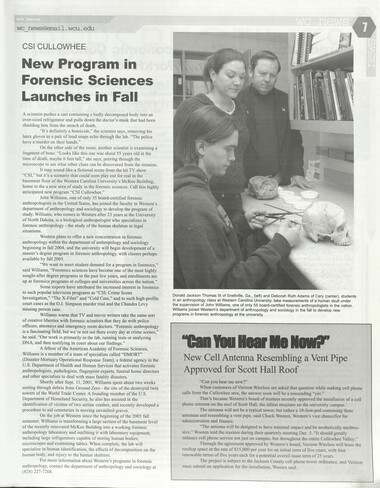Western Carolina University (21)
View all
- Canton Champion Fibre Company (2308)
- Cherokee Traditions (291)
- Civil War in Southern Appalachia (165)
- Craft Revival (1942)
- George Masa Collection (137)
- Great Smoky Mountains - A Park for America (3080)
- Highlights from Western Carolina University (422)
- Horace Kephart (973)
- Journeys Through Jackson (159)
- LGBTQIA+ Archive of Jackson County (89)
- Oral Histories of Western North Carolina (318)
- Picturing Appalachia (6617)
- Stories of Mountain Folk (413)
- Travel Western North Carolina (153)
- Western Carolina University Fine Art Museum Vitreograph Collection (129)
- Western Carolina University Herbarium (92)
- Western Carolina University: Making Memories (738)
- Western Carolina University Publications (2491)
- Western Carolina University Restricted Electronic Theses and Dissertations (146)
- Western North Carolina Regional Maps (71)
- World War II in Southern Appalachia (131)
University of North Carolina Asheville (6)
View all
- Allanstand Cottage Industries (62)
- Appalachian National Park Association (53)
- Bennett, Kelly, 1890-1974 (1463)
- Berry, Walter (76)
- Brasstown Carvers (40)
- Carver, George Washington, 1864?-1943 (26)
- Cathey, Joseph, 1803-1874 (1)
- Champion Fibre Company (233)
- Champion Paper and Fibre Company (297)
- Cherokee Indian Fair Association (16)
- Cherokee Language Program (22)
- Crowe, Amanda (40)
- Edmonston, Thomas Benton, 1842-1907 (7)
- Ensley, A. L. (Abraham Lincoln), 1865-1948 (275)
- Fromer, Irving Rhodes, 1913-1994 (70)
- George Butz (BFS 1907) (46)
- Goodrich, Frances Louisa (120)
- Grant, George Alexander, 1891-1964 (96)
- Heard, Marian Gladys (60)
- Kephart, Calvin, 1883-1969 (15)
- Kephart, Horace, 1862-1931 (313)
- Kephart, Laura, 1862-1954 (67)
- Laney, Gideon Thomas, 1889-1976 (439)
- Masa, George, 1881-1933 (61)
- McElhinney, William Julian, 1896-1953 (44)
- Niggli, Josephina, 1910-1983 (10)
- North Carolina Park Commission (105)
- Osborne, Kezia Stradley (9)
- Owens, Samuel Robert, 1918-1995 (11)
- Penland Weavers and Potters (36)
- Roberts, Vivienne (15)
- Roth, Albert, 1890-1974 (142)
- Schenck, Carl Alwin, 1868-1955 (1)
- Sherrill's Photography Studio (2565)
- Southern Highland Handicraft Guild (127)
- Southern Highlanders, Inc. (71)
- Stalcup, Jesse Bryson (46)
- Stearns, I. K. (213)
- Thompson, James Edward, 1880-1976 (226)
- United States. Indian Arts and Crafts Board (130)
- USFS (683)
- Vance, Zebulon Baird, 1830-1894 (1)
- Weaver, Zebulon, 1872-1948 (58)
- Western Carolina College (230)
- Western Carolina Teachers College (282)
- Western Carolina University (2008)
- Western Carolina University. Mountain Heritage Center (18)
- Whitman, Walt, 1819-1892 (10)
- Wilburn, Hiram Coleman, 1880-1967 (73)
- Williams, Isadora (3)
- Cain, Doreyl Ammons (0)
- Crittenden, Lorraine (0)
- Rhodes, Judy (0)
- Smith, Edward Clark (0)
- Appalachian Region, Southern (3032)
- Asheville (N.C.) (1945)
- Avery County (N.C.) (26)
- Blount County (Tenn.) (195)
- Buncombe County (N.C.) (1680)
- Cherokee County (N.C.) (283)
- Clay County (N.C.) (556)
- Graham County (N.C.) (238)
- Great Smoky Mountains National Park (N.C. and Tenn.) (525)
- Haywood County (N.C.) (3573)
- Henderson County (N.C.) (70)
- Jackson County (N.C.) (4925)
- Knox County (Tenn.) (35)
- Knoxville (Tenn.) (13)
- Lake Santeetlah (N.C.) (10)
- Macon County (N.C.) (421)
- Madison County (N.C.) (216)
- McDowell County (N.C.) (39)
- Mitchell County (N.C.) (135)
- Polk County (N.C.) (35)
- Qualla Boundary (982)
- Rutherford County (N.C.) (78)
- Swain County (N.C.) (2185)
- Transylvania County (N.C.) (270)
- Watauga County (N.C.) (12)
- Waynesville (N.C.) (86)
- Yancey County (N.C.) (72)
- Aerial Photographs (3)
- Aerial Views (60)
- Albums (books) (4)
- Articles (1)
- Artifacts (object Genre) (228)
- Bibliographies (1)
- Biography (general Genre) (2)
- Cards (information Artifacts) (38)
- Clippings (information Artifacts) (192)
- Copybooks (instructional Materials) (3)
- Crafts (art Genres) (622)
- Depictions (visual Works) (21)
- Design Drawings (1)
- Digital Moving Image Formats (2)
- Drawings (visual Works) (185)
- Envelopes (101)
- Exhibitions (events) (1)
- Facsimiles (reproductions) (1)
- Fiction (general Genre) (4)
- Financial Records (12)
- Fliers (printed Matter) (67)
- Glass Plate Negatives (381)
- Guidebooks (2)
- Internegatives (10)
- Interviews (823)
- Land Surveys (102)
- Letters (correspondence) (1045)
- Manuscripts (documents) (618)
- Maps (documents) (177)
- Memorandums (25)
- Minutes (administrative Records) (59)
- Negatives (photographs) (6090)
- Newsletters (1290)
- Newspapers (2)
- Notebooks (8)
- Occupation Currency (1)
- Paintings (visual Works) (1)
- Pen And Ink Drawings (1)
- Periodicals (194)
- Personal Narratives (10)
- Photographs (12977)
- Plans (maps) (1)
- Poetry (6)
- Portraits (4568)
- Postcards (329)
- Programs (documents) (181)
- Publications (documents) (2444)
- Questionnaires (65)
- Relief Prints (26)
- Sayings (literary Genre) (1)
- Scrapbooks (282)
- Sheet Music (2)
- Slides (photographs) (402)
- Songs (musical Compositions) (2)
- Sound Recordings (802)
- Specimens (92)
- Speeches (documents) (18)
- Tintypes (photographs) (8)
- Transcripts (329)
- Text Messages (0)
- A.L. Ensley Collection (275)
- Appalachian Industrial School Records (7)
- Appalachian National Park Association Records (336)
- Axley-Meroney Collection (2)
- Bayard Wootten Photograph Collection (20)
- Bethel Rural Community Organization Collection (7)
- Blumer Collection (5)
- C.W. Slagle Collection (20)
- Canton Area Historical Museum (2110)
- Carlos C. Campbell Collection (462)
- Cataloochee History Project (64)
- Cherokee Studies Collection (4)
- Daisy Dame Photograph Album (5)
- Daniel Boone VI Collection (1)
- Doris Ulmann Photograph Collection (112)
- Elizabeth H. Lasley Collection (1)
- Elizabeth Woolworth Szold Fleharty Collection (4)
- Frank Fry Collection (95)
- George Masa Collection (173)
- Gideon Laney Collection (452)
- Hazel Scarborough Collection (2)
- Hiram C. Wilburn Papers (28)
- Historic Photographs Collection (236)
- Horace Kephart Collection (861)
- Humbard Collection (33)
- Hunter and Weaver Families Collection (1)
- I. D. Blumenthal Collection (4)
- Isadora Williams Collection (4)
- Jesse Bryson Stalcup Collection (47)
- Jim Thompson Collection (224)
- John B. Battle Collection (7)
- John C. Campbell Folk School Records (80)
- John Parris Collection (6)
- Judaculla Rock project (2)
- Kelly Bennett Collection (1482)
- Love Family Papers (11)
- Major Wiley Parris Civil War Letters (3)
- Map Collection (12)
- McFee-Misemer Civil War Letters (34)
- Mountain Heritage Center Collection (4)
- Norburn - Robertson - Thomson Families Collection (44)
- Pauline Hood Collection (7)
- Pre-Guild Collection (2)
- Qualla Arts and Crafts Mutual Collection (12)
- R.A. Romanes Collection (681)
- Rosser H. Taylor Collection (1)
- Samuel Robert Owens Collection (94)
- Sara Madison Collection (144)
- Sherrill Studio Photo Collection (2558)
- Smoky Mountains Hiking Club Collection (616)
- Stories of Mountain Folk - Radio Programs (374)
- The Reporter, Western Carolina University (510)
- Venoy and Elizabeth Reed Collection (16)
- WCU Gender and Sexuality Oral History Project (36)
- WCU Mountain Heritage Center Oral Histories (25)
- WCU Oral History Collection - Mountain People, Mountain Lives (71)
- WCU Students Newspapers Collection (1923)
- Western North Carolina Tomorrow Black Oral History Project (69)
- William Williams Stringfield Collection (2)
- Zebulon Weaver Collection (109)
- African Americans (390)
- Appalachian Trail (35)
- Artisans (521)
- Cherokee art (84)
- Cherokee artists -- North Carolina (10)
- Cherokee language (21)
- Cherokee pottery (101)
- Cherokee women (208)
- Church buildings (190)
- Civilian Conservation Corps (U.S.) (111)
- College student newspapers and periodicals (2012)
- Dams (108)
- Dance (1023)
- Education (222)
- Floods (63)
- Folk music (1015)
- Forced removal, 1813-1903 (2)
- Forest conservation (220)
- Forests and forestry (1198)
- Gender nonconformity (4)
- Great Smoky Mountains National Park (N.C. and Tenn.) (181)
- Hunting (47)
- Landscape photography (25)
- Logging (122)
- Maps (83)
- Mines and mineral resources (9)
- North Carolina -- Maps (18)
- Paper industry (38)
- Postcards (255)
- Pottery (135)
- Railroad trains (72)
- Rural electrification -- North Carolina, Western (3)
- School integration -- Southern States (2)
- Segregation -- North Carolina, Western (5)
- Slavery (5)
- Sports (452)
- Storytelling (243)
- Waterfalls -- Great Smoky Mountains (N.C. and Tenn.) (66)
- Weaving -- Appalachian Region, Southern (280)
- Wood-carving -- Appalachian Region, Southern (328)
- World War, 1939-1945 (173)
Western Carolinian Volume 68 Number 08
Item
Item’s are ‘child’ level descriptions to ‘parent’ objects, (e.g. one page of a whole book).
-
-
| LOWE IS Ih THE AIR What are You Really Getting for Valentines Day? Not All STDs Have Visible Signs or Symptoms By Emily Weaver | WC Are you sure you are safe from a sexually transmitted disease? Health Services reported that out of the hundreds of people who are tested on campus for an STD, 5 to 10 percent are infected with one. This accounts for as little as 1 out of 10 people that are actually tested at WCU. The most prevalent STD on campus and nationwide is Genital Warts, said Jetf Davis, a physician at Western Carolina University. The estimated national statistics for this infection are variable to different areas of the country but can be as high as 30 to 50 percent of the sexually active population. Our numbers at WCU are not that high, probably around 20 percent. Affecting 10 to 20 percent, Genital Herpes is the second most common STD on campus. The American Social Health Association (ASHA) reports as many as | in 4 Americans have genital herpes and 80 percent of those with the disease are unaware they have it due to lack of symptoms. Both of these are viral infections and easily passed through unprotected sex, Davis said. Genital Warts is caused by the Human Papilloma Virus (HPV) and appears as wart-like growths in the genital area or as abnormal cell changes. According to the ASHA website, Some studies show that the majority of the sexually active population is exposed to at least one or more types of HPV - although most do not develop symptoms. Because HPV is so common and prevalent, a person does not need to have a lot of sexual partners to come into contact with this virus. HPV is curable and is not considered life threatening, although high risk forms may eventually lead to cervical cancer if not treated. Women are encouraged to receive regular check-ups to detect any abnormal cell fluctuations. Genital herpes is a chronic skin condition, which can cause irritations in the genital area, Like all viruses, there is no cure for this ailment, and though uncomfortable, it is not suspected to be life threatening. The virus can travel through nerve pathways in the body and lay dormant, not causing an outbreak for long periods of time. Another serious STD that can be difficult to detect with the human eye is HIV infection. The Human Immunodeficiency Virus (HIV) is a virus that attacks the immune system resulting in Acquired Immunodeficiency Syndrome (AIDS), reports ASHA. AIDS and HIV are also incurable, but unlike herpes, the two diseases are life threatening. These viruses weaken the immune system to the point where medical intervention, often resulting in hospitalization, is needed to treat a serious illness. HIV is not easily contracted, HIV can only be contracted through the transmission of sexual fluids or infected blood. Contrary to some myths, the disease cannot be caused by swimming in the same pool as someone with HIV, mosquito bites, sharing everyday items, coughing or sneezing. Blood tests are required to detect the HIV virus. Hepatitis B (HBV) is a virus that is contracted in the same ways as HIV. It can only be contracted through the transmission of infected blood, semen or vaginal secretions. This virus eats away at the liver causing cirrhosis (scarring of the liver), cancer and death. According to ASHA, It is estimated that 5,000 people die each year in the United States due to the complications of cirrhosis and liver cancer as a result of HBV. Although HBV is a lifelong virus, people who are at risk, or wish to never be at risk, can receive vaccination shots to prevent infection. The shots would also keep you safe from Hepatitis D, which can only coexist in the body with HBV. Ifa person has contracted or is believed to have contracted the illness, the vaccine may prevent the virus if given seven days after initial contact. The vaccine includes three shots given periodically within a 4-month time frame. The most prevalent STD on campus and nationwide is Genital Warts, said University Health Services physician Jeff Davis. The estimated national statistics for this infection are variable to different areas of the country but can be as high as 30 to 50 percent of the sexually active population. Our numbers at WCU are not that high, probably around 20 percent. The most common bacterial STD is Chlamydia, affecting 10 to 15 percent of the population, Davis said. Chlamydia can be asymptomatic (without symptoms) for up to two years and sometimes is only detected by routine cultures during a PAP exam. This STD is very similar to another bacterial disease, gonorrhea, and can be treated with antibiotics prescribed by a doctor. Gonorrhea, AKA the clap, is a curable bacterial infection spread through oral, anal or vaginal sex. It can cause pain or a burning sensation as well as a pus- like discharge. A majority of men will experience symptoms 2 to 5 days after contracting the illness, but most women will not experience any symptoms. Those who do will usually experience them up to 10 days later. In 90 percent of the cases, people experienced no symptoms. Another curable sexually transmitted infection, syphilis, is caused by the bacteria treponema pallidum. This STD is more common here in the southeast, although the disease in itself is not as common as others. Jack the Ripper is believed to have been infected with syphilis. Chlamydia, Gonorrhea and other bacterial diseases, if not treated, can turn into Pelvic Inflammatory Disease (PID), which infects the female reproductive organs and can lead to infertility in women. This disease is most common between women aged 15 to 25 and can be either sexually transmitted or naturally occurring. If left untreated, PID may lead to infertility, cystitis (inflammation of the urinary bladder), ectopic (tubal) pregnancy, recurrent episodes of PID and chronic pelvic pain, ASHA reported.
Object
Object’s are ‘parent’ level descriptions to ‘children’ items, (e.g. a book with pages).
-
The Western Carolinian is Western Carolina University's student-run newspaper. The paper was published as the Cullowhee Yodel from 1924 to 1931 before changing its name to The Western Carolinian in 1933.
-




























































































